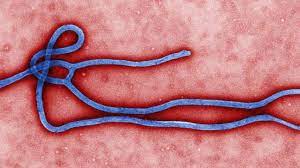Ebola Virus:

The World Health Organisation (WHO) has declared that the Ebola outbreak, that started in February 2021 in Guinea, is over now.
- In its first deadly wave in 2013-2016, the Ebola outbreak killed 11,300 people, mostly in Guinea, Sierra Leone and Liberia.
- The WHO in its list of “Ten threats to global health in 2019” also included Ebola.
About Ebola Virus Disease (EVD):
- EVD, formerly known as Ebola haemorrhagic fever, is transmitted to people from wild animals and spreads in the human population through human to human transmission.
- Ebola virus was first discovered in 1976 near the Ebola River in what is now the Democratic Republic of Congo.
- Transmission: Fruit bats of the Pteropodidae family are natural Ebola virus hosts.
- Animal to Human Transmission: Ebola is introduced into the human population through close contact with the blood, secretions, organs or other bodily fluids of infected animals such as fruit bats, chimpanzees, gorillas, monkeys, forest antelope or porcupines found ill or dead or in the rainforest.
- Human-to-Human Transmission: Ebola spreads via direct contact (through broken skin or mucous membranes) with:
Blood or body fluids of a person who is sick with or has died from Ebola. - Objects that have been contaminated with such body fluids (like blood, feces, vomit).
- Symptoms:
- These can be sudden and include: Fever, Fatigue, Muscle pain, Headache, Sore throat, Vomiting, Diarrhoea, Symptoms of impaired kidney and liver function, in some cases, both internal and external bleeding.
- It can be difficult to clinically distinguish Ebola from other infectious diseases such as malaria, typhoid fever, and meningitis but confirmation that symptoms are caused by Ebola virus infection are made using the following.




